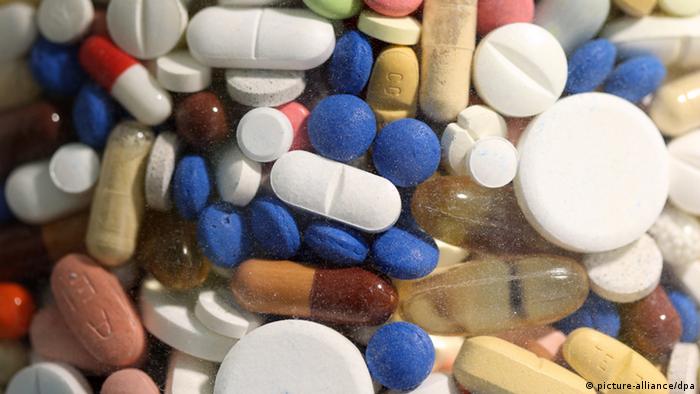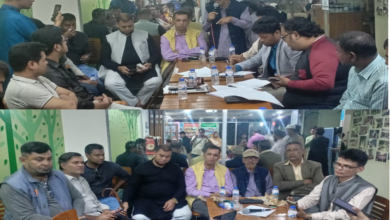
China Between Disease and Medicine
What is the relationship between the medications we take every day and China?
There is a possibility that any medicine you have taken during the past ten years has its main source from China, even if it says “Made in Switzerland” on the medicine box, but the source of the main ingredients from which this medicine is made is China.
At the end of July 2019, the US Economic and Security Review Committee held an important meeting at the US Senate Headquarters to discuss the very sensitive subject of the US heavy dependence on Chinese pharmaceutical products. Christopher Brice, chief of staff, U.S. Defense Health Agency, the agency responsible for providing medical services to all branches of the U.S. military and armed forces, was the first to speak at the meeting.
Brice noted a major problem: China dominates the global pharmaceutical sector. The Pentagon procures drugs only from China, while the main components of the remaining medicines the Defense Department procures from other countries also come from China.
So Brice expressed concern that China could control the U.S. by exploiting that sector and deny it access to important pharmaceutical items the Pentagon might need as armed forces on the battlefield.
As a result of Brice’s statements, he drew the attention of many officials not only in America but also in the world to the Chinese domination of the pharmaceutical sector, as most international pharmaceutical companies, regardless of their nationality, rely on China for supply of their effective components. The impact of this dependence was evident when the Chinese borders were closed by the coronavirus pandemic crisis, where factories stopped, creating a severe crisis in the international pharmaceutical companies and the impact on the prices of medicine everywhere.
Surprisingly, this is a new situation; As China has not been an influential element in this sector.
– What has changed?
– And how did China’s tremendous capacity in the pharmaceutical sector occur worldwide?
– And what is the story of the Chinese active substances that are involved in the manufacture of so many drugs in the world?
– What is the reason for the lack of a competitor to China in this field?
In 2020, a shipment of pharmaceutical raw materials ordered by a Japanese pharmaceutical company, Katsura Chemical, was delayed from India, causing its Chairman, Taro Katsura, to worry, because the delay was for no logical reason. The Chairman of the Japanese pharmaceutical company kept calling and inquiring about the reason for the delay of the shipment from the Indian company using all means of communication, such as telephone and e-mail. Every time he heard the same response from the Indian company (no worries), the shipment is coming to you, but in fact nothing arrives.
The Japanese company eventually discovered that the raw pharmaceutical material that his company buys from India is manufactured by another chemical that is made only in China in a particular company, and this Chinese company was stalled at that time because of the closure measures taken by the Chinese government to limit the spread of the Coronavirus. In short, the Japanese company is waiting for the raw pharmaceutical material from India, and the Indian company is waiting for the important component that goes into the manufacture of the raw pharmaceutical material, and this simple scene shows China’s vital role in the global pharmaceutical industry.
China does not manufacture all or much of the world’s medicines, but most of the world’s medicines are made with Chinese chemical components, which scientists specifically call “Active Pharmaceutical Ingredients”
Active pharmaceutical ingredients, which many people call “active substance.”
But why is it important to have active substances?
How is it manufactured from scratch?
This active substance is made primarily from chemical raw materials called Key Starting Materials (SKMS), which are subject to certain reactions and chemicals until they eventually produce an active substance to treat certain symptoms or diseases. It should be noted, however, that the active substance is not the drug, but it is the most important component of any drug.
For example, an effective painkiller is made up mainly of two basic elements:
1- (ABI) – The active substance responsible for pain relief.
2- (Excipients), which are ineffective aids added to the active substance.
Most often, drug companies do not manufacture the active substances for the drugs they sell in the company’s name, but there are other companies that specialize in the manufacture of these active substances such as India’s Davis or Japan’s Katsura Chemical, to which we have referred, and there are many other companies responsible for the production of SKMS from which the active substance is made.
The pharmaceutical industry is undergoing three basic stages:
First: Key Starting Materials are produced.
Second: The active substance is made from it.
Third: the final drug is made from the active substance and then sold in pharmacies.
Most often, pharmaceutical companies buy the active substance at the ready from other companies and add Excipients and sell it on the market under different brand names. This is why more than one drug is on the market with the same active substance but different brand names.
Noting the fundamentals of the pharmaceutical market, China is the world’s largest producer and exporter of active substances.
China alone controls almost half of the global active-materials market, giving it significant control over all global pharmaceutical companies, a new situation because, as of the mid-1990s, the West and Japan were producing about 90% of the effective pharmaceuticals. China has had little presence in this sensitive sector, but the situation has changed in the last 20 years.
The UK’s Medicines and Healthcare Products Regulatory Agency estimates that China has produced nearly 40% of the world’s active substances, and the remaining 60% is not far from China either. For example, the generic antibiotic Levofloxacin is produced by three companies, one in China and two in Japan. Surprisingly, the two companies from Japan buy the active substance in its initial form before the purification phase from China, meaning that Japanese companies have only purified the active substance that was originally made in China.
India boasts one of the largest pharmaceutical sectors in the world, but is in fact dependent on China for its production. According to European Commission data, India accounts for 20% of the global supply of generic or equivalent medicines, qualifying it to be the world’s largest supplier of generic medicines. India is a major giant in this area, but relies on China to import about 70% of its active substance without which India would not produce any medicines and there would be no pharmaceutical sector in India at all.
In the face of this reality, the question is whether India is making active substance on its own.
Yes, India manufactures active substances, but in fact, it manufactures active substances using SKMS from China. For example, India manufactures Lamivudine, which is used to manufacture HIV-related drugs. However, its manufacture relies heavily on a Key Starting Materials called cytosine from China, which means that China is the main source of drugs.
As a result, the head of the Japan Pharmaceutical Manufacturers Association (JPMA), Ichiro Fudekawa, declared that tracking the supply chain of the pharmaceutical industry ultimately leads to China, which leads to a logical question:
How did China get there?
At the beginning of the new millennium, the Chinese began to pay attention to the importance of active substances and their vital role in an important and sensitive industry, which is the pharmaceutical industry, which all countries consider part of their national security, so the Chinese began to pump huge investments in the manufacture of active substances.
At the same time, the Chinese government provided great facilities to companies operating in this field in order to help them expand therein, by approving some regulations and laws that attract international pharmaceutical companies, and among these decisions is the Drug Registration Management Procedures Law, and it came into force as of date of May 1st, 2005, as this law allowed companies producing active substances to obtain approvals faster from the competent authorities.
One of the results of the expansion in this field was that China was distinguished by the low cost of pharmaceutical materials, and the reason is that the greater the volume of production, the more there will be cost savings. For example, China has a manufacturing capacity that allows it to produce 14,000 tons of the antibiotic known as (amoxicillin), while India’s capacity to produce the same pharmaceutical substance is only 5,000 five thousand tons, and this result was according to research conducted by (KPMG INDIA) in cooperation with the Confederation of Indian Industry (CII).
Also, one of the reasons for the low costs of Starting Key Materials (SKMS) in China is that the raw materials that go into the manufacture of active substances are available in China in large quantities at cheap prices, and this is a very important advantage; The reason for this is that the cost of these raw materials represents two-thirds of the cost of producing the active substance. Therefore, for example, a factory in China can produce a kilogram of the antibiotic known as (lamivudine) for USD 120, while a competing factory in India produces the same active substance at a price At least USD 137.
The low cost of pharmaceutical raw materials in India helped Chinese companies that manufacture active substances to compete with Europeans, Americans and Japanese, and enabled China to own a growing share in the global drug market, which made Western pharmaceutical companies depend on the Chinese product in their desire to save every possible dollar, and this is in addition to that when Western companies rely on China to provide active substances, they get rid of the strict preventive measures imposed on them by Western governments because of the chemical reactions that occur during the manufacture of active substances, which may sometimes result in toxic substances.
Therefore, Western and Japanese companies have turned away from making active materials and have relied heavily on China, either moving their factories to China or discontinuing the manufacture of active substances, relying on the Chinese instead. China has monopolized the manufacture of some active substances, and no one else manufactures them.
In the year 2008, a well-known book was published and caused a stir upon its issuance, entitled “China RX, Exposing the Dangers of America’s Dependence on Medicine and This,” written by Rosemary Gibson. In this book, the author mentioned that Western pharmaceutical companies have contributed in one way or another to the expansion of the active substance industry in China, and she gave a number of examples, including that the famous American pharmaceutical company, Pfizer, opened a huge center of research and development in Shanghai in 2005, then two years later it closed the development center of Pfizer in Ann Albor, Michigan, USA, and then two years later it closed the private research laboratories in Princeton, New Jersey, New York, and North Carolina, and in 2011, Pfizer laid off more than 2,000 researchers at the company as part of a plan to cut spending, and among those researchers were 1,100 researchers working at the company’s largest research site in Kentucky.
Pfizer has been divesting research in the United States and investing and pumping more money into its research activity in China, which is one reason why the American firm, like other companies, relies on China for a large part of its active materials needs.
In the researcher’s testimony before the US Senate in March 2020.
She said:
China alone produces 90% of the chemical components that go into making very important drugs like tranquilizers, antibiotics, anti-inflammatory drugs, and blood pressure drugs. These are important drugs in the middle of the Coronavirus crisis, so when the pandemic emerged three years ago, a number of countries took notice of the danger of relying on China for raw materials.
In March 2020, the Indian government imposed restrictions on its exports of 28 active substances, which are involved in the manufacture of a number of drugs, such as paracetamol and clindamycin. The reason for this is that the Indian government decided to keep these drugs in India for the benefit of its people in light of the coronavirus crisis, which it did not know when it would end.
India did not increase production, for example, instead of placing restrictions on exports because these active materials include starting chemicals that come from China, and there was no clear vision regarding India obtaining more starting materials from China during the Corona crisis.
Associate Professor at the Institute of Industrial Development Studies in India Reggie Joseph considers that Indian national security is in danger due to India’s dependence on Chinese starting materials, and Joseph gives an example of the antibiotic (penicillin) that India manufactures based on Chinese raw materials.
So what would it be if China stopped exports to India for any reason, leading to a serious drug problem, Joseph said. A big problem in India, he added, is that there is no company making penicillin starting materials. At the same time, it is not easy to find an alternative to the Chinese resource because everyone depends on China.
China is producing active substances for more than 2,000 medicines, and another penicillin manufacturing plant in the United States was shut down in 2004. According to US Commerce Department data, Americans began supplying their penicillin needs from China, with America importing nearly 45% of its penicillin imports in 2018. The US also imported 95% of its ibuprofen imports, 91% of hydrocortisone imports and 70% of its acetaminophen imports from China.
As for India, after the Corona crisis, in March of the year 2020 it developed a plan to encourage local production of active materials and starting materials at a value of USD 900 million, which the French did as well three months after India’s decision, specifically in June of the year 2020, When French President Macron visited a site belonging to the French pharmaceutical company “Sanofi”, Macron announced a plan aimed at resettling the active pharmaceutical industry in France and Europe.
The French plan was simply to return again to manufacture (ABI) or the active substance of “Paracetamol” within a period of three years, and the reason for choosing this substance is that Paracetamol is one of the most sold drugs in France, and the French were manufacturing that active substance for Paracetamol compound in a factory in the south of France that was shut down in 2008.
Here, a question arises:
Where are we as Arabs in this global competition?
The Arab countries possess sufficient competencies and capital, so what prevents the Arab countries from following in the footsteps of China and entering this sensitive and important sector such as the active pharmaceuticals substances sector?
Has China become the exclusive drug savior of the world?
And if a war breaks out between China and Taiwan, will we suffer from the loss of medicines and their high prices, as we suffer today from the loss of energy and its high prices due to the Russian-Ukrainian war?
Can what be happening be a lesson for countries to wake up from their slumber and dependence on national industries in all fields?
Or will we witness more suffering and lack of materials with every crisis and every war?
All that we have raised needs time to find the answer to it, but what we are certain of is that the world after wars, crises and epidemics will not be the same as before.
Khaled Zein Eddine.
Editor in Chief of the European Arab International Newspaper.
Member of the International Federation of Journalists in Brussels.
Member of the Polish Press Syndicate.




